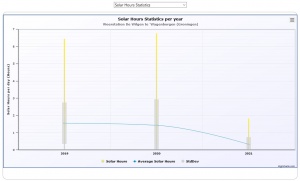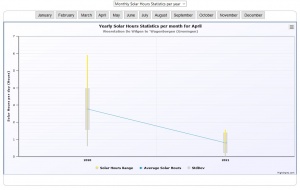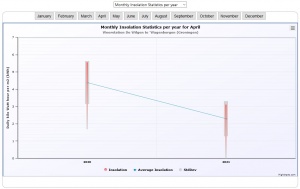Charts - Solar charts: Difference between revisions
(Initial edit) |
mNo edit summary |
||
| (12 intermediate revisions by the same user not shown) | |||
| Line 1: | Line 1: | ||
== Introduction == |
== Introduction == |
||
These charts are only available if the station has a solar sensor for measuring the solar radiation. |
|||
| ⚫ | |||
| ⚫ | |||
Wind Rose - Plotting the wind direction and speed in a polar chart; |
|||
Monthly Rain - Plotting the wind speed in a stacked column chart; |
|||
#Solar hours statistics - Plotting the range, average and estimator for the standard deviation for the solar hours per year |
|||
| ⚫ | |||
#Monthly solar hours statistics per year - Plotting the range, average and estimator for the standard deviation for the solar hours per month per year |
|||
#Insolation statistics - Plotting the range, average and estimator for the standard deviation for the solar energy per year |
|||
#Monthly Insolation statistics per year - Plotting the range, average and estimator for the standard deviation for the solar energy per month per year |
|||
| ⚫ | |||
== Wind Rose == |
|||
For the insolation graphs the method of calculation is explained. |
|||
The rather complex chart presents the wind speed and direction in a so called polar chart. For each direction in the compass rose a stacked column is displayed as a cone towards the centre (or from the centre outward). The display is subdivided for every year and every month within the year. |
|||
For the calculations the standard C# LINQ-functions Min, Max and Avg are used. For the standard deviation this [https://stackoverflow.com/questions/2253874/standard-deviation-in-linq LINQ-extension] is used with a modification for a minimum number of observations required of 2, if less the StdDev returns 0 (zero). |
|||
The chart is configured with the following parameters (explained in [[Charts#WindRoseNrOfWindforceClasses_.26_WindRoseMaxWindSpeed|the chapter Charts]]): |
|||
NOTE: for years where no solar sensor was present the chart displays the value 0 on all charts. The possibility not to display the years at all has not been implemented. |
|||
WindRoseNrOfWindforceClasses=6 (default = 6) |
|||
WindRoseMaxWindSpeed=60 (default = 60) |
|||
== Solar hours statistics == |
|||
=== Calculation of the Wind Rose === |
|||
[[File:Solar Hours Statistics.jpg|thumb|right|Solar hour statistics per year]] |
|||
The wind rose is based on the figures in the [[Standard_log_files|monthly log files]]. Those files are read and every measurement has a ''Latest Wind Speed'' (See [[Standard_log_files#Cumulus_Wind_Speed_Terminology|terminology]], [[Standard_log_files#Version_1.8.5:|field nr 14]]). |
|||
For all days in a year the value of field 25, ''Total hours of sunshine'' (see [[Dayfile.txt|Dayfile]]), is taken and the resulting statistics are calculated and plotted. |
|||
== Monthly solar hours statistics per year == |
|||
The direction is taken from the Current Windbearing, [[Standard_log_files#Added_in_1.9.2|field nr 25]]. However, field nr 25 does exist only from version 1.9.2 and up. If the datafile is from an earlier version the next best value is taken for the wind direction namely the average windbearing, [[Standard_log_files#Version_1.8.5:|field nr 8]]. |
|||
[[File:Monthly solar hours statistics per year.jpg|thumb|right|Monthly solar hours statistics per year]] |
|||
For all days in a month in a year, the value of field 25, ''Total hours of sunshine'' (see [[Dayfile.txt|Dayfile]]), is taken and the resulting statistics are calculated and plotted. |
|||
== Insolation statistics == |
|||
Every record in the database is taken as a sample and counted for the speed and direction classes and as such presented in the chart. Especially for the high frequency sampling (one or five minutes) this will give an accurate picture of the wind speed and direction figures. For the lower frequency sampling this picture may be less accurate for the month level. |
|||
[[File:Insolation statistics.jpg|thumb|right|Insolation statistics per year]] |
|||
For an explanation of this chart it is necessary to explain the insolation first. |
|||
We measure [https://en.wikipedia.org/wiki/Solar_irradiance Solar Irradiance] as the power per unit area received from the Sun in the form of electromagnetic radiation as measured in the wavelength range of the measuring instrument (your solar sensor of your weather station). ''CumulusMX'' stores this in [[Standard_log_files|the monthly logs]] as the value of the ''Solar Radiation'' (field nr 19) at that moment. It is the momentary solar power in W/m<sup>2</sup>. |
|||
The Solar Insolation for a given time period is the integration of the measured Solar Radiation values. Or as the wiki says: |
|||
''Solar irradiance is often integrated over a given time period in order to report the radiant energy emitted into the surrounding environment (joule per square metre, J/m2) during that time period. This integrated solar irradiance is called solar irradiation, solar exposure, solar insolation, or insolation.'' |
|||
So if we take R for Radiation (which we sample in field 19) we get for a time period of a day: |
|||
<math>\int{R} \, dt</math> |
|||
=== Using Numerical Integration === |
|||
But because we do not have continuous measurement we have to approximate this by taking the samples of the ''Solar Radiation'' we do have for the sampling interval we use (1, 5, 10 etc... minutes). We use the theory of [https://en.wikipedia.org/wiki/Numerical_integration#Quadrature_rules_based_on_interpolating_functions Numerical Integration]. Assuming equal distance <math>\Delta t</math> between the samples and a not too disruptive radiation function we get an approximation for the integral as: |
|||
<math>\sum_{0}^{\sum_{\Delta t}} ({field19} \times \, \Delta t)</math> |
|||
for all samples, assuming the measured value is the midpoint of |
|||
<math>t + \frac{1}{2}\times \Delta t</math> and <math>t - \frac{1}{2}\times \Delta t</math>. |
|||
=== Variable interval === |
|||
However this interval appears not to be constant in the reality of ''CumulusMX''. Not only appears the user to change the interval once in a while but also in the start and stop sequence of CMX and for other reasons unknown there appear to be smaller and larger 'gaps' in the data resulting in time interval changes which have been found to be unpredictable. As a result an algorithmic solution has been applied to reduce the influence of the interval size. With a bit of grandeur you might say it is an integration with variable step size. |
|||
=== Method of calculation === |
|||
#A list of monthly logfile entries is created for each day where the theoretical solar max radiation is above zero (i.e. the sun is up) |
|||
#The interval in minutes is the sampling interval (loginterval) the user has assigned in the CumulusMX settings (1, 5, 10, 15, 20 or 30 minutes) |
|||
#Then in a loop over all values, each time it is checked if the interval setting corresponds with the realised interval. If not the interval is adjusted to the new value. |
|||
#If the interval is larger then 30 minutes the gap is too large and the value is skipped, no addition is made, the calculation is restarted at the next entry. |
|||
#The Energy over the interval is calculated as <math>{SolarRad} \times {Interval} \times 60</math> to get the energy in Ws and summed up to the total for the day. |
|||
#At the end of the day the total energy sum in Ws is converted to KWh by <math>{the\ energy\ sum} \div {3600 \div 1000}</math> |
|||
NOTE: during this process the actual calculation of the solar hours is also executed. All calculation are done in one pass. The creation of the actual charts data consists merely of the selection of the data from the resulting list. |
|||
== Monthly Insolation statistics per year == |
|||
[[File:Monthly insolation statistics per year.jpg|thumb|right|Monthly insolation statistics per year]] |
|||
The chart is analogue to the previous chart for all years. |
|||
[[Category:CumulusUtils]] |
|||
Latest revision as of 11:49, 9 April 2021
Introduction
These charts are only available if the station has a solar sensor for measuring the solar radiation.
The Solar charts submodule consists of four charts:
- Solar hours statistics - Plotting the range, average and estimator for the standard deviation for the solar hours per year
- Monthly solar hours statistics per year - Plotting the range, average and estimator for the standard deviation for the solar hours per month per year
- Insolation statistics - Plotting the range, average and estimator for the standard deviation for the solar energy per year
- Monthly Insolation statistics per year - Plotting the range, average and estimator for the standard deviation for the solar energy per month per year
Below you will find an example image of each chart and an explanation of the origin of the numbers. For the insolation graphs the method of calculation is explained.
For the calculations the standard C# LINQ-functions Min, Max and Avg are used. For the standard deviation this LINQ-extension is used with a modification for a minimum number of observations required of 2, if less the StdDev returns 0 (zero).
NOTE: for years where no solar sensor was present the chart displays the value 0 on all charts. The possibility not to display the years at all has not been implemented.
Solar hours statistics
For all days in a year the value of field 25, Total hours of sunshine (see Dayfile), is taken and the resulting statistics are calculated and plotted.
Monthly solar hours statistics per year
For all days in a month in a year, the value of field 25, Total hours of sunshine (see Dayfile), is taken and the resulting statistics are calculated and plotted.
Insolation statistics
For an explanation of this chart it is necessary to explain the insolation first.
We measure Solar Irradiance as the power per unit area received from the Sun in the form of electromagnetic radiation as measured in the wavelength range of the measuring instrument (your solar sensor of your weather station). CumulusMX stores this in the monthly logs as the value of the Solar Radiation (field nr 19) at that moment. It is the momentary solar power in W/m2.
The Solar Insolation for a given time period is the integration of the measured Solar Radiation values. Or as the wiki says:
Solar irradiance is often integrated over a given time period in order to report the radiant energy emitted into the surrounding environment (joule per square metre, J/m2) during that time period. This integrated solar irradiance is called solar irradiation, solar exposure, solar insolation, or insolation.
So if we take R for Radiation (which we sample in field 19) we get for a time period of a day:
Using Numerical Integration
But because we do not have continuous measurement we have to approximate this by taking the samples of the Solar Radiation we do have for the sampling interval we use (1, 5, 10 etc... minutes). We use the theory of Numerical Integration. Assuming equal distance between the samples and a not too disruptive radiation function we get an approximation for the integral as:
for all samples, assuming the measured value is the midpoint of
and .
Variable interval
However this interval appears not to be constant in the reality of CumulusMX. Not only appears the user to change the interval once in a while but also in the start and stop sequence of CMX and for other reasons unknown there appear to be smaller and larger 'gaps' in the data resulting in time interval changes which have been found to be unpredictable. As a result an algorithmic solution has been applied to reduce the influence of the interval size. With a bit of grandeur you might say it is an integration with variable step size.
Method of calculation
- A list of monthly logfile entries is created for each day where the theoretical solar max radiation is above zero (i.e. the sun is up)
- The interval in minutes is the sampling interval (loginterval) the user has assigned in the CumulusMX settings (1, 5, 10, 15, 20 or 30 minutes)
- Then in a loop over all values, each time it is checked if the interval setting corresponds with the realised interval. If not the interval is adjusted to the new value.
- If the interval is larger then 30 minutes the gap is too large and the value is skipped, no addition is made, the calculation is restarted at the next entry.
- The Energy over the interval is calculated as to get the energy in Ws and summed up to the total for the day.
- At the end of the day the total energy sum in Ws is converted to KWh by
NOTE: during this process the actual calculation of the solar hours is also executed. All calculation are done in one pass. The creation of the actual charts data consists merely of the selection of the data from the resulting list.
Monthly Insolation statistics per year
The chart is analogue to the previous chart for all years.










